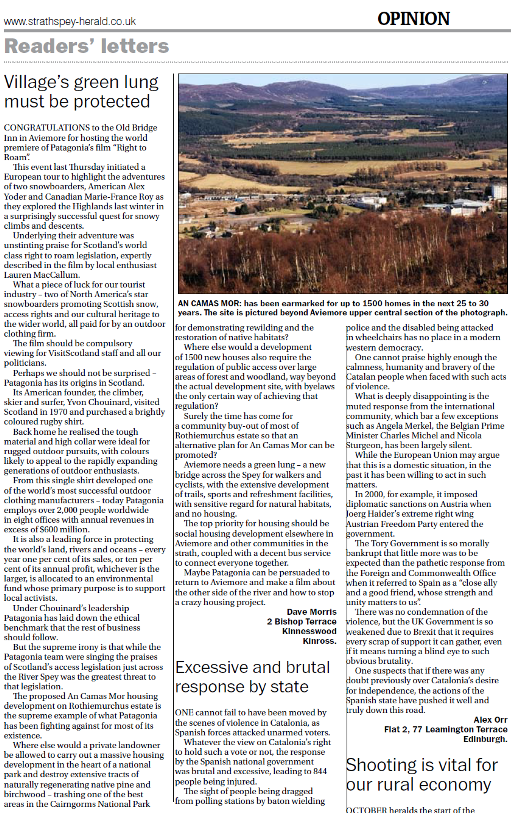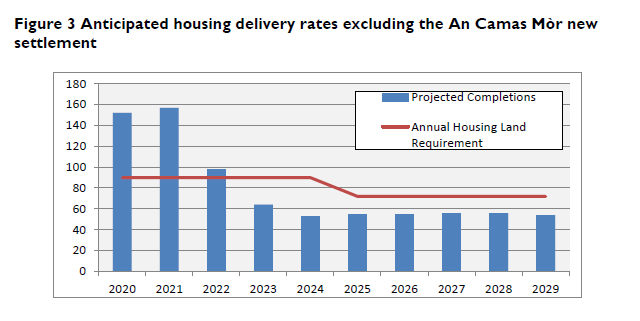
Arguably the most important item on the agenda of the Cairngorms National Park Authority Board Meeting on Friday (link to papers) was the Local Development Plan. The current five year plan was approved two and a half years ago but the consultation for the next one is due to start at the end of the year. The Board was being asked to consider the draft “Main Issues Report” for consultation. It contains many important issues (which I will come back to) and a significant discussion about An Camas Mor.
When the CNPA Board renewed the planning permission for An Camas Mor for a paltry £203 under Section 42 of the Planning Act in the summer, part of their argument was they had no choice but to do so. This was because the land at An Camas Mor was set aside for housing in the existing Local Development Plan. There is a danger here of a circular argument, planning permission is granted because a new town at ACM is in the Local Development Plan and then the Local Development Plan allocates the site for a new town because……its been granted planning permission. This could go on for years!
In what I see as a significant development the Main Issues report identifies a way out of this circular argument based on the Scottish Government’s targets for new build housing in the National Park:
We will continue to work with the site owners and their design team to deliver An Camas Mòr. However, it is also possible that An Camas Mòr will not be delivered. The next Local Development Plan needs to be able to adapt to those circumstances if they happen and have alternative ways of meeting the National Park’s housing land requirements in the event that the site is unable to be developed.
The argument is that if ACM is not built, the CNPA’s proposed housing targest would be missed so the CNPA is suggesting setting aside alternative land for housing. Its suggestion is land at the northern edge of Aviemore which, it says:
“is close to the existing road network, mains water supplies, sewage infrastructure and electricity supplies and would link to existing services and facilities in Aviemore.”
In other words, the infrastructure costs associated with development would be signficantly less and so make the development more likely to go ahead. If that is the case, however, why not just choose the site now and ditch ACM?

There is lots of other interesting information in the report (the CNPA is in a different league to the Loch Lomond and Trossachs National Park Authority when it comes to providing evidence about its plans – the draft LLTNPA National Partnership contains no proper evidence). This evidence I believe will further assist with opening up a debate about whether ACM is a sensible solution to the Park’s housing problems. Take the chart above (which excludes ACM which is projected to provide 50 accommodation units a year till it reaches 1500). This shows that in 2020 and 2021 new housing completions will exceed the Park’s target and by my reckoning this surplus offsets the shortfall between 2023 and 2026. From then on the projected shortfall is only 20 houses a year, far less than the 50 a year ACM claims it will provide. So, why is ACM needed on the Park’s projected “Annual Housing Land Requirement”?
If the Park’s projections of either demand or supply are wrong and fewer new houses are needed – for example if the number of vacant houses in the National Park could be reduced – there would be no justification for ACM at all.
The Local Development Plan is also proposing to increase the proportion of affordable housing in new housing developments from the Scottish benchmark of 25% to 45% in Aviemore and Blair Atholl because of the shocking levels of low pay in the National Park (average pay is well below the Scottish average). Now, I think this is a commendable move in the right direction, even if its not clear if this applies to ACM as well as Aviemore. It should do though and, if it did, it would be very interesting to know if ACM would still go ahead (because of the high cost of new infrastructure).
Although the CNPA is saying in the Main Issues Report that it will do all it can to facilitate ACM, the logic of the Plan and the evidence seems to me to point to a different conclusion: that is it would be much better use of public money to plan for social housing elsewhere NOW and not wait for ACM to fail. This would also avoid an access stushi and, most important of all, the destruction of one of the finest areas of regenerating native woodland (see here) in the National Park. The consultation on the Local Development Plan offers an opportunity to stop the new town madness that is An Camas Mor and for the CNPA to meet its objectives both for conservation and sustainable development.
It is 1 mile from An Camas Mor to Aviemore Railway Station, this is the same as the distance from the station to the Co-op in Dalfaber. Further sprawl to the north of the village, between Aviemore and the dump, will get further and further from this vital transport connection, and the amenities of Aviemore https://www.ancamasmor.com/ . You perspicaciously raise the issue of infrastructure costs but this is not just about roads and sewage- it include a community hall, library, primary school, the Aviemore Countryside Park, The Aviemore Sports Centre, shops, play parks. In short, all the things that make life pleasurable, not just possible, the amenities that enable us to lead healthy and fulfilling lives. Most commercial house builders develop land for a quick profit in about 3 -5 years. This means, there is little commercial incentive to invest early-on in infrastructure and community facilities. The north of Aviemore is a case example of this- there has been new housing without the infrastructure, community amenities and green space to support that development. What makes An Camas Mor different is that it is not a conventional profit-driven development- it will be a sustainable community planned over 30 -50 years, so there is a clear incentive to invest early on in the infrastructure, workspace and community facilities to support a thriving community. A long-term plan means that there is also an incentive for the developer to design homes that people who work locally can afford, to create an economically sustainable community. Early investment in infrastructure means that spaces we need for living, working, learning are properly integrated, enabling people to live more sustainable lifestyles. Do we really want more houses near a dump, without the workspace, shops, community amenities and parks to support that community? Do we want to live in sprawling housing estates? Or can we aspire to more sustainable ways of life ?
Hi Alexandra,
Last time you posted here I asked if you were related in any way to Johnnie Grant? You chose to avoid an open reply but I now have information to say both that he has a daughter called Alexandra and that that person may be working on the ACM development. I think it would help readers and the cause of openness if you could answer both questions. I have no objection to people working for ACM contributing to parkswatch – the blog is dedicated to promoting informed debate – but part of being informed is knowing where people are coming from.
The suggestion by the CNPA in their Main Issues Report of North Aviemore offering an alternative should ACM fail to be delivered is of course also open to debate and I would expect ACM to object to that in their response to that report. It will be interesting to see how other people respond but this might included suggestions of other areas for housing which are not centred around Aviemore (which already has a number of sites dedicated to housing) but are elsewhere in the National Park. As Dave Morris’ letter to the Strathy commented, if communities were better connected by bus there would be no need for people to live so close to Aviemore. Moreover, what the CNPA’s projected demand shows, is there is no need for a whole new town with expensive infrastructure. I am repeating myself but great concept, wrong place.
Sadly, I think that at present the distance of either ACM or North Aviemore from the railway station is probably not a relevant site consideration due to the poor train service. If part of the demand for new housing in Aviemore and indeed ACM is from Inverness commuters, as is suggested by the A9 dualling project which has prioritised the section between Inverness and Aviemore over that further south (and of course has been prioritised over rail line improvements), a development in north Aviemore would reduce commuting time and be better situated.
October 9, 2017 at 5:35 pm
Your comment is awaiting moderation.
It should be absolutely clear that the views I have expressed on your website are not representative of An Camas Mor LLP; James or Johnnie Grant or any individual or organisation connected to An Camas Mor LLP (https://www.ancamasmor.com/people/ )- please don’t take them as such. I have not received any kind of financial incentive or renumeration for any ‘work’ I have undertaken for An Camas Mor LLP. I avoided your question because I don’t think it’s relevant to my comments: I know my own mind, I don’t think anyone likes to be defined solely by their background. Whether or not An Camas Mor would object to building between Aviemore and the dump is not something I can comment on, I can only comment as someone with an understanding of the local area. Commuting by bus or car breaks every principle environmental principle and has significant social and psychological costs that have been very well researched https://www.ncbi.nlm.nih.gov/pubmed/15576620 https://ideas.repec.org/a/eee/jhecon/v30y2011i5p1064-1076.html. whereas active commuting on foot has significant health benefits https://www.ncbi.nlm.nih.gov/pubmed/17475317. I see your point about Aviemore growing at a faster rate that other communities but I don’t see how limiting the housing stock is a solution? It is the recipe for an unfair society: a limited housing supply will just push rents and house prices up even further and possibly cause over-crowding and social problems. The young people who work in Aviemore will end up commuting, and the old people and the second-home owners will be left living in a socially isolated community. I don’t see how a community where children grow up at a distance from their grand-parents, where parents work far away from where their children go to school is a way of life that any of us should aspire to. Fundamental principles of social justice and fairness demand that we should find a better, more environmentally friendly solution that includes everyone. An Camas Mor could solve this.